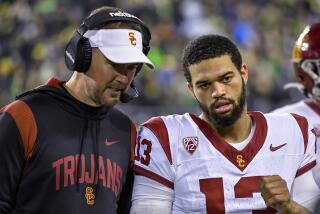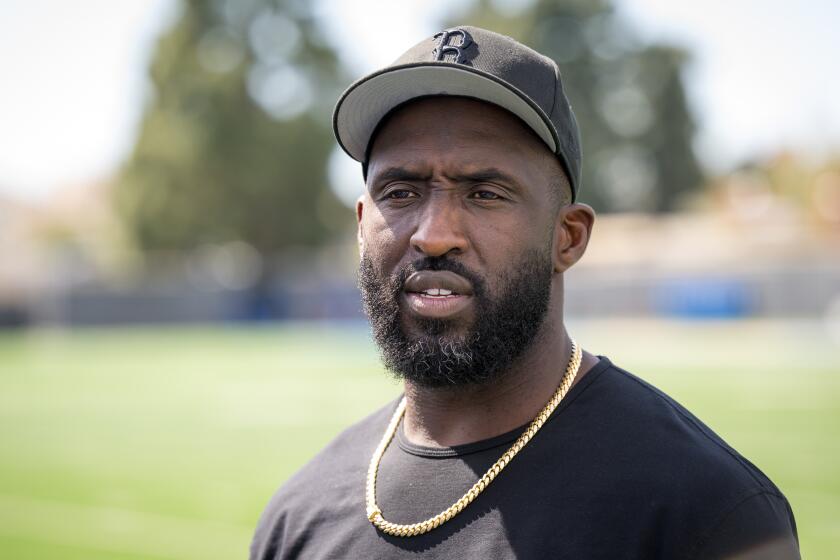THE OTHER PAT RIELLY : This One Is a Leader, Too, as the New President of Professional Golfers’ Assn.
- Share via
The Lakers’ Pat Riley isn’t the only man in town with that name who is No. 1 in his sport.
The spelling may be different, but meet Pat Rielly, director of golf at the Annandale Golf Club in Pasadena, and the recently elected president of the Professional Golfers’ Assn. of America.
Rielly, 53, heads the largest professional sports organization in the world--16,000 members who are employed at more than 6,000 golf courses. He is only the second Southern Californian to serve as president of the PGA in its 72-year history. The late Joe Novak of Bel-Air held the office from 1948 to 1951.
“Boundaries are being broken down in golf, as far as the professional is concerned, but as we approach the year 2000, the PGA must be in the forefront in building, developing and expanding the sport,” Rielly said of the future of the PGA.
Rielly uses the year 2000 because it reflects the change in philosophy that he and two other officers, past president J. R. Carpenter of Hattiesburg, Miss., and Vice President Dick Smith of Cherry Hill, N. J., are trying to instill in the organization.
“For years, the president of the PGA came aboard every 2 years with his own plan, usually geared to a pet project . . . and there were never any long-range goals spelled out. The three of us have been working for more than 2 years on a plan to improve the stature of the club professional as a more professional person and at the same time meet the needs of the sport’s primary constituency--the amateur golfer.
“The direction of the PGA, in the past, was aimed more at the organization, rather than the membership. Our direction is to be more member-oriented.”
Toward that end, Rielly hopes to change the image of the golf professional from that of an athlete who is physically talented in the game he plays, or teaches, to that of an athlete-businessman.
His role models are Joe Walser and Ernie Vossler, Oklahoma golf professionals who founded Landmark Land Company, Inc., which owns and operates Mission Hills, site of the Nabisco Dinah Shore women’s tournament; PGA West, a multi-course complex that serves as the western home of the PGA; and 10 other golf or golf-oriented facilities.
“Joe and Ernie have done more to elevate the stature of the club professional than anyone else I can think of,” Rielly said. “More of us should aspire to top management jobs such as they hold, and the PGA is dedicated to helping create opportunities for similar positions through an educational program.
“We are also starting a PGA club management company to act as a consultant to members. It will serve as a data base for the needs of the club professional.
“By the year 2000, to fill the demands of amateur golfers, we will need 4,000 new courses in the next 11 years. That is a golf course a day. We have seen only 175 built this year so already we are lagging behind. The opportunities in our game are limitless, but we have to push and study and work to make them happen.”
Another barrier that Rielly has worked at breaking down is the Eastern Establishment influence in the PGA. He believes that, with the help of former presidents Joe Black of Dallas and Mark Kizzier of Bartlesville, Okla., the direction has turned to the West.
“This is where it’s at now, no doubt about it,” Rielly said. “Until the last decade, it was almost impossible to get the Eastern board members to even talk about what was happening west of the Mississippi, much less do anything about it. It was a geographical-philosophical sort of thing. But there are no boundaries now.”
Rielly is an Easterner, too, by birth, but since being brought West to Camp Pendleton by the Marine Corps, he has not returned except for visits.
The golf bug hit Rielly while he was shagging balls at the Sharon, (Pa.) Country Club when he was 11.
“I made about a dollar a day, but that was a dollar more than any other 11-year-old in Sharon was making,” Rielly recalled proudly. “When I got big enough, I started to caddie, but they only made $1.25 for a round and 10 cents of that went to the caddie master.
“The pro there was an old Scotsman, George Swankee, and I watched him teach day after day and I guess I was an imitator because when I started to play, the game came easy for me. I seemed to have learned my swing from watching him.”
Rielly soon was winning caddie tournaments and at 17 won the Shenango Valley Amateur in Pennsylvania. He won it for a second time under unusual circumstances.
“The day of the finals, I was supposed to be practicing for the Western Pennsylvania vs. Eastern Ohio high school all-star football game. I was the quarterback and everyone at the tournament thought I’d have to forfeit the final match but at the last minute the coach let me off and I beat the guy.”
Missing the football practice apparently didn’t hurt, either. Rielly was named most valuable player when Western Pennsylvania rallied in the final 2 minutes and won, 14-13. After lettering 4 years in golf, 3 in football and 2 in basketball at Sharon High, Rielly enrolled at Penn State.
“From the time I played golf as a freshman in high school and went to Penn State to play in the state championship tournament, there was never any doubt where I was going to college,” he said. “There was no other place to be, and I still feel that way.”
He graduated in 1958 with degrees in business and labor management and an assignment with the Marine Corps for 4 years. After mustering out as a captain, Rielly took a job as an assistant in the pro shop at the Circle R Ranch course in nearby Escondido.
“While I was there, I tried to find a sponsor so I could play on the tour,” he said. “I felt I could make it out there, but later that year when I got the head professional’s job at El Camino Country Club in Oceanside, I changed my thinking.
“I knew I could play, but I also knew I was no Arnold Palmer. I had a wife and three kids (at the time) and the economics of the thing told me to stay at El Camino. To this day, I have no regrets. I have been comfortable as a golf professional, rather than as a professional golfer, and I’ve received enough recognition for my game to satisfy my ego.”
Rielly won the San Diego County Open and was named player of the year while at El Camino. He also qualified for the United States Open.
“I have one goal outstanding as a player,” he said. “I am very goal oriented and I fully expect to make it next year, and that is to be the first PGA officer in history to play in a major championship. I wanted to do it this year but the day of qualifying for the Senior Open conflicted with the Oldsmobile Scramble, which I had to attend, in Orlando, Fla. I’ll do it next year, though.”
Rielly began his move up the ladder toward presidency of the PGA while he was at El Camino, although he didn’t know it at first.
“I joined the PGA in 1966 and it wasn’t long before I realized that I wasn’t pleased with the plight of the club professional. I decided the way to do something about it was get to work and make my presence known.”
In his second year, he was appointed to the Southern California PGA board and 2 years later was its president. He served 3 years, 2 while at the Oceanside course and the other after moving to Annandale in 1972.
“The more I saw, the more I thought more needed to be done,” he said. “The section president goes back to the annual (national) meeting each year and I soon found out that West Coast thinking was virtually ignored. Once I decided to take the first step and speak out, I was in it all the way.
“It was definitely an East Coast-West Coast association then, with the East Coast making all the decisions. The organization was less than willing to become involved in this part of the country, but we got a big push from Landmark when it built PGA West in La Quinta. That turned a lot of heads this way and the Southern California section’s merchandise show also helped shape the change in attitude.
“Once the tide began to shift, there was no stopping it. Like I said, this is where it’s at now.”
Pat Rielly’s name, more often than not, is misspelled, Reilly. That’s what it was once. And before that it was O’Reilly.
But when Pat’s father was baptized, the printer made a mistake and spelled the name Rielly.
“My grandfather wouldn’t change it because he said he didn’t have the money to pay the printer again,” Rielly said. “So my dad stayed with Rielly all his life. It’s even confusing in the family, too, because all my cousins are Reillys and I’m a Rielly.
“It used to be O’Reilly, but when the family came over from Ireland and landed at Ellis Island, some friends told them to drop the O so people wouldn’t know we were Irish. It wasn’t fashionable to be an Irishman in those days.”
He also gets confused with the Lakers’ Riley. When Arnold Palmer came to Annandale for an exhibition last month with Rielly, Peter Jacobsen and Jan Stephenson, the Pasadena Star-News identified he home club pro as the Laker coach.
Rielly credits his wife and four children, and the membership and staff at the Annandale Golf Club, as much as his own drive and determination for his ascendancy to the PGA presidency.
“I’ll be gone 100 days or more from the club this coming year and if the members weren’t willing to accept my absence, and my staff wasn’t willing to work overtime, I couldn’t do it,” he said. “This is a most unusual club. It is one of the oldest (founded in 1894) in Southern California and it has a long history of giving to golf.
“Lynn Smith (a former Annandale member who served on the United States Golf Assn. board for many years) gave his life to golf. He should have been president of the USGA. He earned it. But he got caught in that geographical thing where he wasn’t from the right side of the country.”
Three of Rielly’s children are working in golf, or golf-related businesses.
His oldest daughter, Suzie, attended Stanford on a golf scholarship and is now working with Landmark. One son, Mike, also went to Stanford and works with Mark McCormack at International Management Group in the golf division. Another daughter, Maggi, is a senior at Menlo College and hopes to become a fashion designer.
Son Rick became one of the youngest head professionals of a prestigious club in the country when he succeeded the retired Frank Morey at Wilshire last year when he was 26. Rick, who played at the University of Arizona, had worked at La Jolla C.C. before getting the Wilshire job.
“Rick got his PGA card and really got his act together early,” Rielly said. “One of the highlights of my becoming president came when Rick nominated me for the position at the meeting in New Orleans. All my family was there, and my brother and his wife, and it was a very moving experience, having a son talk about his father as only he could.
“He told them about the lesson I learned from my father, that there was a right way, and wrong way and a Rielly way to do things, and that the Rielly way was usually the right way. I’m proudest not of what I’ve done in the PGA, but of my family.
“The kids have over 200 trophies at home and it wasn’t just because they were all good golfers. More than that, it meant that (wife) Sue drove a lot of miles when they were little.”
When Rielly feels the need to unwind from his administrative duties, both with the PGA and at Annandale, he does it by playing golf.
“You can’t let yourself stay keyed up with business all the time,” he said. “Now and then, you’ve got to have some quiet time, and quiet time for me is getting out on the course. I never tire of the game.
“I’m envious of my job. I like it because I enjoy what I’m doing. Imagine getting up every morning and heading for the golf course to go to your office.”
More to Read
Go beyond the scoreboard
Get the latest on L.A.'s teams in the daily Sports Report newsletter.
You may occasionally receive promotional content from the Los Angeles Times.










